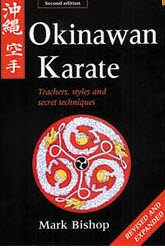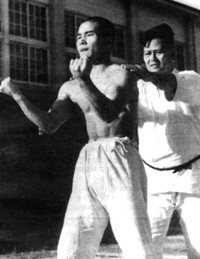Quite possibly the stupidest thing I have ever read about karate.
by Ryan Gregory, August 11th, 2013I was looking through my copy of Okinawan Karate: Teachers, Styles and Secret Techniques by Mark Bishop, and I skipped to the section on Goju-ryu to see what he had to say. Below is the section that really caught my attention, reproduced in its entirety with my comments (in italics) interspersed throughout.
Goju-ryu and health
During the course of my research I met quite a few karate teachers who berated Goju-ryu for its general hardness and warned me to discontinue the training (which I eventually did) or face high blood pressure-related illnesses and a premature death.
Not teachers of competing styles, surely! What reason could they possibly have for berating Goju-ryu?
The critics gained much of their visual evidence from watching unskilled practitioners doing dynamic-tension demonstrations of Sanchin.
I see. So, they base their “visual evidence” on unreliable information. Gotcha.
In this exercise all the body muscles are hardened into one rigid structure as the sweating demonstrator performs the Sanchin moves as if pushing against a heavy weight, whilst being punched and kicked by an associate and issuing a loud guttural “hiss”.
During Sanchin exercise, I was told, certain blood vessels are shut off at the limb joints, the blood cannot flow freely, reverses and accumulates around the chest, neck, and shoulders causing a red flush in that area. Blood vessels of the neck and arms become swollen as the heart tries in vain to keep the circulation going and forces the blood up to the brain. The result of the exertion on the heart, blood vessels and internal organs is not considered by critics to be good for the health, and regular daily practice is said to be the cause of high blood pressure and obesity amongst Goju-ryu practitioners over the age of 40. Rumour also has it that some older practitioners have difficulty lifting their arms higher than their shoulders.
I have never met a Goju-ryu practitioner who couldn’t raise their arms above their shoulders. Certainly, Chojun Miyagi’s top students had no such problems in their old age.
Moreover, is there any evidence whatsoever of increased rates of high blood pressure among Goju-ryu practitioners?
And what on Earth is the possible connection with obesity that the author imagines?
Finally, it should go without saying that if “the heart tries in vain to keep the circulation going” — meaning that it tries but fails — obesity won’t be the problem, instant death will be the problem.
Although this type of dynamic-tension Sanchin training is fast becoming popular, I could find no really convincing explanations for its practice, apart from being a crowd gatherer and a somewhat dangerous body builder.
Read: I could find no convincing explanation for the practices of Goju-ryu by people unfamiliar with Goju-ryu.
Whether or not Chojun Miyagi encouraged dynamic-tension and the resulting overall hardening process of Goju-ryu is not clear…
‘Nuff said.
…but the fact that premature deaths through illnesses associated with high blood pressure are common among Goju-ryu practitioners cannot be disputed.
Actually, it can be disputed quite easily because there is no evidence to support these claims. Chojun Miyagi may have died at the relatively young age of 65 of a heart attack, but Ei’ichi Miyazato was 77, Seikichi Toguchi was 81, Meitoku Yagi was 91, Gogen Yamaguchi was 80, and Morio Higaonna is 74 and still practicing.
The following is a generalisation of other “evidence” passed on to me by those who believed Goju-ryu practice to be coincidental with poor health:
1. In order to harden the buttocks during the Sanchin exercise, forceful closing of the anal sphincter is practised. This, I was assured, will result in haemorrhoids after only two or three years of regular practice.
I don’t know about the author, but my anal sphincter is closed by default. In fact, the definition of a sphincter is “a circular muscle that normally maintains constriction of a natural body passage or orifice and which relaxes as required by normal physiological functioning.”
The sphincter ani externus muscle is under some voluntary control, but this is not the same thing as tightening the large muscles of the buttocks. In any case, this wouldn’t be a significant cause of haemorrhoids anyway:
“The exact cause of symptomatic hemorrhoids is unknown. A number of factors are believed to play a role including: irregular bowel habits (constipation or diarrhea), a lack of exercise, nutritional factors (low-fiber diets), increased intra-abdominal pressure (prolonged straining [i.e. pushing, not tightening], ascitis, an intra-abdominal mass, or pregnancy), genetics, an absence of valves within the hemorrhoidal veins, and aging.”
2. When blocking, the thumb side of the fist is forced sideways towards the forearm, causing pressure to be exerted on a vital point at the side of the wrist. This point may be detected by relaxing the left hand and running the thumb of the right hand to the base of the left thumb until a hollow is found. Even slight pressure at this point will bring pain. In actual fact, an abnormal amount of pressure should not be exerted here as, I was assured, it will have adverse effects on the lungs which may result in various lung complaints including TB and asthma.
Let me get this straight. Even touching this spot can cause significant pain, but Goju-ryu practitioners regularly whack each others’ arms with it while blocking and either a) don’t feel it, or b) are too stupid to change how they block? Also, banging on this spot on the wrist will mess up your lungs? And it will cause tuberculosis (infection by Mycobacterium tuberculosis) and asthma in particular? Um, ok.
3. The testing of Sanchin “hardness”, by punching and kicking the abdomen, will have adverse effects on the intestines and may result in stomach cancer.
I see. You heard it here, folks. Apparently being hit in the abdomen while doing your kata can give you stomach cancer. Never mind the fact that most stomach cancer is associated with infection by Helicobacter pylori and/or other risk factors such as smoking and/or genetic factors.
Maybe the rest of the book is great, but man this section sure was not researched or thought out well.



 Brazilian Jiu-Jitsu
Brazilian Jiu-Jitsu
 Kodokan Judo
Kodokan Judo



I don’t know Mr. Bishop but I have his book in which he trashes grand Master Meitoku Yagi based on his observation of A class. I did not agree with his writing on Meibukan Goju-ryu then. As a 25 year practitioner of Goju-ryu Meibukan karate, Sanchin is still my most favorite kata and the health benefits have been awesome.
Ryan, I can hardly wait for your review of the rest of the book! This section at least sounds like the combination of ‘old wives tales’, hearsay, an abominable knowledge of human anatomy, physiology and disease etiology all wrapped up in the most subjective type of observation leading to conclusion I have ever heard.
Anyway, I think I will take my chances and continue to practice Goju-ryu. I believe there are much harder things on your heart such as doing nothing, and likely more risky ways and behaviours for contracting TB and developing cancer! See you in the dojo.